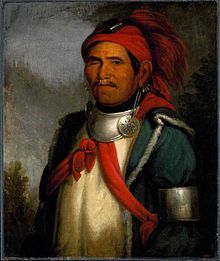Early years[edit]
Tenskwatawa's mother was Methoataske (or Methoataaskee, meaning "[One who] Lays Eggs in the Sand"), who was believed to be either Muscogee Creek, Cherokee, or Shawnee, possibly of Pekowi division and the Turtle Clan.[1][2]
Because his father died before he was born and because his mother left his family shortly after, Lalawethika grew up without parents. Lalawethika was then dependent on his siblings to teach him the Shawnee ways. Because he was not close to his older sister or older brother, he never learned how to hunt or fight successfully, skills essential to a Shawnee man. He also lost an eye in a hunting accident, and his poor looks and braggart personality did not win him many friends. As a result, Lalawethika grew up to be an outsider to his community and turned to alcohol.[2]
Based on his history, it seemed that he would never make a contribution to his tribe. However, that changed when Lalawethika was put in trance by the Master of Life. In May 1805, he experienced the first of several visions. In one of his alcoholic stupors he fell into a fire and was thought dead. Unexpectedly reviving, he recounted a powerful vision and soon began preaching. White (1991) notes that in Algonquian tradition the "Great Serpent" came from the sea and stood for evil powers; Tenskwatawa said Americans came from the sea and were the spawn of the Great Serpent.[3] He also conducted witch hunts against Christian Indians. He forbade his people to use European foods, clothing, manufactured goods and alcohol. He changed his name to Tenskwatawa (The Open Door or One With Open Mouth).
Purification[edit]
Tenskwatawa had a series of religious visions which transformed his life and led him to reject his old ways. More revelations followed in succeeding months, revelations that the white invaders from the east were “not my children, but the children of the Evil Spirit.".[4] He led a purification movement to return his people to their traditional ways, and to extirpate the evils represented by the Americans. Indian witches still remained the most active agents of that spirit on earth, and Tenskwatawa sought to identify and destroy them.[5] He formed a new community of followers near the present site ofGreenville, Ohio in 1805. His following grew even more rapidly after he accurately predicted a solar eclipse in 1806 humiliating Indiana Territorial Governor William Henry Harrison. Harrison had publicly derided Tenskwatawa as a fraud to the tribal leaders and the accuracy of Tenskwatawa's prediction was taken as proof of his power by many members of the tribes.
His followers eventually followed him west to form a large multi-tribal community known to the whites as Prophetstown or Tippecanoe in what is now Indiana in 1808. The site had both practical and spiritual significance. The site was located near the juncture of the Wabash and Tippecanoe rivers. Such places at the junction of two rivers had significant spiritual significance in tribal culture. The site was also a geographic central point to the political and military alliance that was forming around Tenskwatawa's brother Tecumseh.
When some chiefs tried to promote compromise and conciliation, Tenskwatawa, proclaiming his obedience to the Great Spirit, lashed out against these government sympathizing chiefs, depicting them as wicked traitors and minions of the Americans.[6]
Willig (1997) argues that Tippecanoe was not only the largest Native American community in the Great Lakes region but served as a major center of Indian culture and base to expel the whites and European culture. It was an inter-tribal, religious stronghold along the Wabash River in Indiana for three thousand Native Americans, Tippecanoe, known as Prophetstown to whites, served as a temporary barrier to settlers' westward movement. Led by Tenskwatawa and Tecumseh, thousands of Algonquin-speaking Indians gathered at Tippecanoe to gain spiritual strength. US government attempts, from the George Washington to William Henry Harrison administrations, to rid the area of the numerous Indian tribes eventually met with success as the Indians retreated westward by 1840 to avoid the large numbers of whites entering their territory.[7]
Tecumseh's War[edit]
Main article: Tecumseh's War
There is some disagreement among historians over whether Tecumseh or Tenskwatawa was really the primary leader of the Pan-Indian community that grew up around Prophetstown. Either way, Tenskwatawa's preachings grew more militant and narrowly political from 1808–1811, as more and more young disaffected warriors from nearby tribes joined his movement. By 1811, both white settlers in the region and the U.S. Army had become quite concerned about what was happening at Prophetstown.
Late in 1811, Tecumseh journeyed south to meet with representatives of other tribes in hopes of building a larger alliance, leaving Tenskwatawa in command at Prophetstown. According to legend, Tecumseh ordered Tenskwatawa to avoid any confrontation with whites during his absence. However, on November 7, 1811, while Tecumseh was still away, an American force under command of William Henry Harrison surrounded the village. Though the village was surrounded, it was Tenskwatawa and his smaller besieged force that attacked first. Tenskwatawa's forces were soundly defeated. (See the Battle of Tippecanoe.) It was a two hour battle that left many dead or wounded. The Indians buried their men in the night, and stripped The Prophet of his powers. The village at Prophetstown was burned down and the defeat put an end to Tecumseh's hope of a broad Native alliance.
With his brother, Tenskwatawa participated in the defense of the Canadian colonies during the War of 1812. In 1813 he was present at the Battle of the Thames, When Tecumseh came back from his journey, he was furious with his brother and many wanted him killed for ruining their chance to keep their land, but Tecumseh sent him away never to come back. Tenskwatawa was not present during Tecumseh's death.


No comments:
Post a Comment